
(Graphics: Multnomah County)
There’s an issue with the forthcoming Burnside Bridge that is vexing county and city planners: How to connect bicycle riders on the east side of the Willamette River up to the new protected bike lanes on the bridge deck – and vice versa.
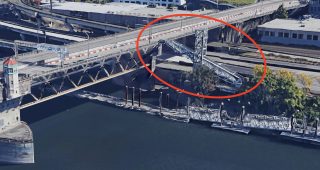
The Eastbank Esplanade is a crucial north-south cycling route that’s currently all but cut off from the Burnside Bridge and the bustling central eastside. Few bicycle users will carry their vehicles up the long flights of stairs that exist today. And if they do, they are dropped on the south side (eastbound) of the bridge and unable to access the westbound bike lane unless they skirt across several lanes of traffic.
Multnomah County (the agency that owns the bridge) wants to make it easier for bicycle riders (and walkers, wheelchair users, scooter riders, and so on) to get on and off their $825 million bridge and they need to have a better connection in place before they break ground in 2024. The current concept is a ramp with switchbacks on the south side of the bridge that would connect to the Esplanade where the staircase is today. And similar to those stairs, it would give bicycle riders only limited access the bridge.
If you were coming eastbound into downtown, you’d have to go against traffic on the bridge to access the ramp. You’d have similar problems if you were on the Esplanade and wanted to go downtown. Both scenarios would require some combinations of dangerous crossing and/or out-of-direction travel.
At last night’s Portland Bureau of Transportation Bicycle Advisory Committee (BAC) meeting, a consultant working with the county asked committee members for their input on two options (see below): extending the ramp under the bridge to the north side, or adding a signalized crossing on the bridge from the south to north side. The options were presented by the project’s technical lead Steve Drahota of HDR, Inc.
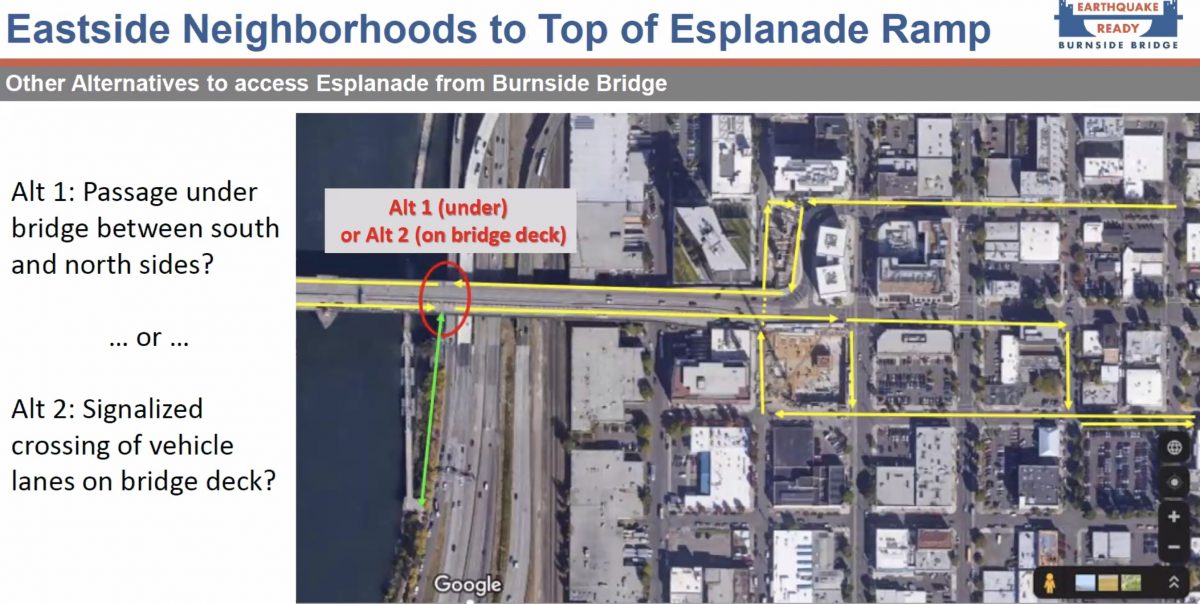
Advertisement
Extended ramp crossing under the bridge
Drahota referred to this as an “under-bridge passageway” that would connect the proposed ramp on the south side to the north side of the bridge. It would be similar to the ramps near the Steel Bridge, but with more vertical gap, it would need three switchbacks instead of two.
A slide Drahota shared showed only two “pros” and a “whole lot of cons.” On the plus side, it wouldn’t impact bridge traffic at all and it would give path users a route to bail out when bridge lifts occur.
On the negative side, the extended ramp would be quite long in order to remain ADA compliant (5% gradient or less) and move people the 50 feet up from the river and across the 115-foot wide bridge. And as many of you know from experience on the I-205 path, underpasses can feel unsafe especially if there are people living on them. Drahota also mentioned that the ramp structure would be more costly to build and maintain and would not be aesthetically pleasing.
Signalized crossing on bridge deck
The County seems to be favoring the option of a traffic signal on the bridge. The signal would give people a safe way to cross the bridge and Drahota said, “We feel this provides a much more intuitive route.” He also rattled off a list of reasons it’s a better option than the extended ramp: It’s a more intuitive connection, it provides better visibility/public safety than an underpass, and it would be cheaper to build.
The downsides of the signal are that it could delay bridge traffic and the bike lane design would have to include waiting zones for people as they queue for the light.
——
Drahota and PBOT Bike Planner Roger Geller also shared last night they’ve discussed two-way bike traffic on the south side off the bridge — either for the entire bridge span or just between Martin Luther King Jr Blvd and the ramp access point.
Drahota said a two-way facility on the south side would be challenging, but not impossible. “Adding a two-way facility across the bridge is not cheap,” he said. “It does build in a pretty hefty price tag. But from a feasibility standpoint, it’s feasible.”
He pointed to width constraints at the Burnside/Martin Luther King Jr. Blvd intersection that wouldn’t provide enough space to create a two-way bike lane on the south side and maintain a bike lane on the north side (of course he makes that calculation while maintaining the vast majority of the road width for standard lanes). Drahota said another option might be to bring bike traffic from SE Ankeny and build a ramp at the location of a building on SE 2nd Avenue that’s slated for development.
There’s also the possibility of removing all non-driving traffic from the north side and putting it on the south side. A two-way bike lane and sidewalk on one side of the bridge makes some connections easier, but it would also come at the cost of losing a bike network connection on the north side of the bridge.
“What do you lose by giving that up? If you don’t have a westbound facility on the north side?” Geller asked rhetorically, “Sure we can make it work two ways on the south side, but that’s the question we need to answer.”
The County is still early in the design phase of the project and these conversations will continue in the coming months. Stay tuned for more coverage and opportunities to share your feedback. Learn more at the County’s website.
— Jonathan Maus: (503) 706-8804, @jonathan_maus on Twitter and jonathan@bikeportland.org
— Get our headlines delivered to your inbox.
— Support this independent community media outlet with a one-time contribution or monthly subscription.


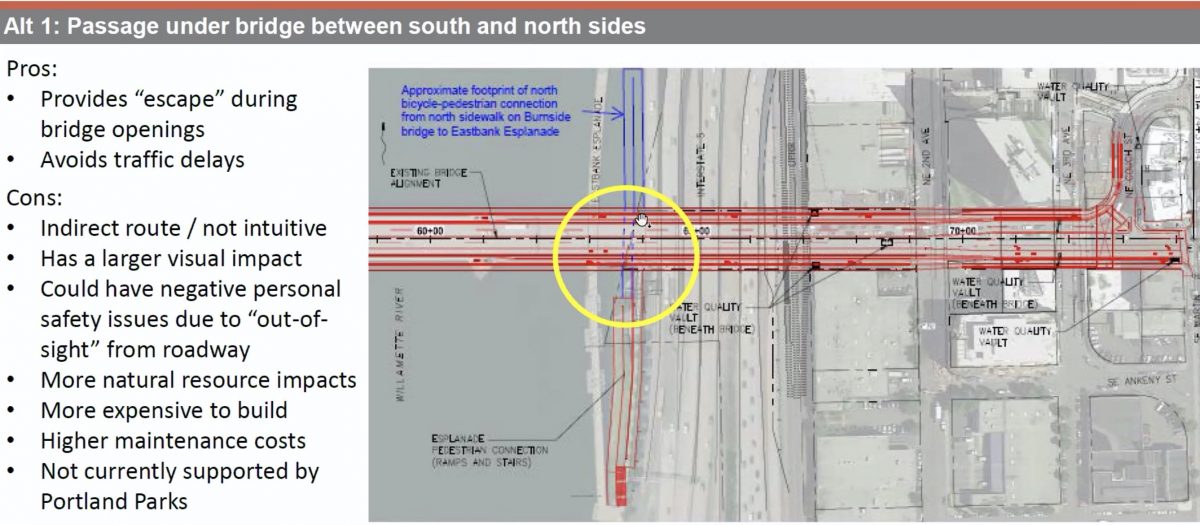

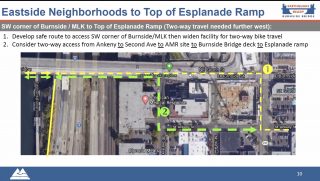
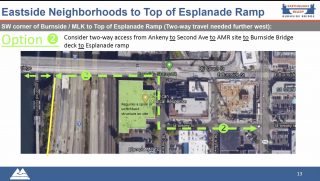

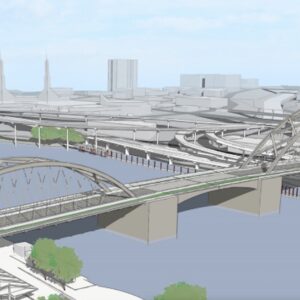


Thanks for reading.
BikePortland has served this community with independent community journalism since 2005. We rely on subscriptions from readers like you to survive. Your financial support is vital in keeping this valuable resource alive and well.
Please subscribe today to strengthen and expand our work.
This is a new bridge being built from scratch. How did we end up with ped and bike access as an add-on late in the design process, and therefore presented as just two options, both heavily compromised?
I5
Note that I-5 is built right over the “Deep Unstable Soils” which are a main design constraint for this very bridge replacement project. The still from that video above shows I-5 under the Burnside eastside access ramps right in the very worst place possible.
The cheapest way to ensure that those unstable soils don’t threaten I-5 itself through Portland would be to simply change the map: where I-5 currently runs through unstable near-river soils between I-84 and SW Portland, you’d reroute I-5 through what is now called I-405.
Now that we’ve saved I-5 by getting rid of the unsafe part, and of course replaced the unsafe part with something much less earthquake-vulnerable like a large linear park, this whole question of access becomes drastically simpler: you just go from Burnside Bridge to 2nd Ave, then loop around from there through a ground-level park and over to the Eastside Esplanade.
Yep. Great point. So evidence from turbidites gives us a window for choosing to do this or waiting until it is chosen for us. Unfortunately, much of the W Hills may undergo soil liquefaction, so I’m not sure how safe 405 will be. I’m not a geologist, so someone more familiar with the research chime in please.
Can we all jusr imagine what a 5% grade in a manual wheelchair is really like for a disabled person? Try it, you will see exactly what I’m talking about. They should conside a 3% grade ramp instead. Also, the spiral ramps are not ada compliant for wheelchairs. An elevator is impractical due to maintenance issues, but is easiest for disabled people. Let’s not make people with disabilities an afterthought in the design of something new.
Excellent point. I remember when a library in Queens had one of its first tours and someone pointed out that almost the entire fiction section was inaccessible (ie built between levels accessible only by stairs. We often have options that get us directly to point X, but for someone with a disability it may take several more steps. Ramps and elevators should prioritize people with disabilities and shorten trips.
Remove I5. Build practical, simple, straight long ramps in its place to connect each pbl on each side of the bridge.
Yeah…that’s not happening. Let’s shoot for realistic goals instead of throwing ideas out there that have a 0% chance of happening.
Frankly, I think that removing I-5 would be a horrible idea if we want better active transportation. Drivers that would have used it will instead use surface streets, completely clogging them up and making them much more hostile to active transportation than they already are. It would be sixty steps in the wrong direction if we want livable, walkable, and bikeable streets, which should be our goal here. Bury it, absolutely. Remove it, hell no.
Not to mention that I really don’t see the feds letting that happen. The interstate freeway system was funded by the federal government in large part to allow the quick deployment of military equipment if need be. They already paid for I-5 and I doubt that they are going to let it go.
That’s a good point. Some removals have been funded by the TIGER grant. There was a bill (below) that stalled I think, but may have some hope after the election. I-5 and 405 are parallel. There’s no question of redundancy.
https://usa.streetsblog.org/2019/08/14/federal-program-would-help-cities-tear-down-highways/
Even if you removed the freeway or buried it, you still have the UP rail main line to cross.
Technically interstates are state roads, not federal, except sometimes when they cross major water bodies (like the Columbia River). The feds paid for most of the initial funding in the 1950s through 90s, but since then it’s been mostly state funding. The I-5 bridges across the Columbia River were built long before the interstate system was even a concept (i.e. before WW2) by ODOT and WaDOT, or by their 1930s equivalents. The I-205 bridge is much newer of course, as are the Marquam and Fremont bridges, paid for mostly by Uncle Sam. Harbor Drive was also pre-interstate, built in the late 1940s, though it did later have the I-5 designation – it’s crossing of the Willamette used the still privately-owned Steel Bridge.
The I-5 Southbound bridge across the Columbia was built as part of the interstate system in the ’50s. The Northbound span opened in the teens.
Exactly what people said when people proposed to remove Harbor Drive in 1974.
Got a source for that statement? I have no clue what the public sentiment was like then (I wasn’t even alive) so cannot say either way.
Sure, thanks for asking. Let me know if you need more.
“Because of the traffic engineers’ objections, the Task Force did not even consider the option of closing Harbor Drive. State Highway Engineer Forrest Cooper said that would be totally impossible, because his projections showed there would be 90,000 trips per day in the corridor by 1990.”
“On the day Jackson had to present a plan to the Portland City Council, he called Ivey to his office. He told Ivey that Portland Traffic Engineer Don Bergstrom was saying that closing Harbor Drive would back traffic up all the way to Lake Oswego. He showed Ivey an editorial in that day’s Oregonian saying that it was impossible to close Harbor Drive, because the traffic engineers in Salem and Portland said it would not work.”
http://www.preservenet.com/freeways/FreewaysHarbor.html
Thank you for the source and being one of the only people here who has provided one when I’ve asked for one. TBH I’m more interested in what public sentiment was like rather than sentiment among traffic engineers. Did the public support it? From my experiences, the public sentiment is strongly against removing I-5 (every single person I talk to outside of activist circles actively opposes it). Whereas, that link has the direct quote that “the public clearly wanted to consider the possibility of completely eliminating Harbor Drive”, which I have yet to see in the case of I-5.
If you are aware of the Robert Moses era you may know that multiple freeways were proposed through both white and black neighborhoods across the US in all cities. Unfortunately, for obvious reasons based in racism, those neighborhoods which were majority white (eg SOHO in NY, and SE Pland) were more successful in opposing Moses’ ideology. Many people still swallow the idea that if not entirely good, at least freeways are a necessary evil in cities. ODOT appears to still hold onto the traditional Moses view. In any case, they are not even necessary. Many cities have removed freeways in the city center and had little to no affect on congestion. Induced demand works in reverse. Unfortunately, as with the SF central freeway, it may be most feasible to remove I5 after the big one hits.
Here are some case studies.
https://www.cnu.org/sites/default/files/Nashville%20Case%20Study%202%20-%20Seattle.pdf
Note: The following was supposed to be a reply to the comment below, but, you know, my spastic reply syndrome kicked in.
==========
It is also silly business to pretend we can remove a heavily used arterial freeway without any negative consequences on the rest of the system. It’s not like someone will wave their negative-induced-demand wand and those trips will just magically disappear.
I would love to get rid of I-5 as much as anyone, but we also have to acknowledge the reality that a lot of people use it, and most will find an alternative, and that alternative might just be the street that you or I bike on.
And yet, that is exactly what occurs more often than not. The “necessary evil” theory of I-5 is slowly replacing the Robert Moses ideology. Someday we might find out it’s not actually necessary.
https://opencommons.uconn.edu/cgi/viewcontent.cgi?referer=&httpsredir=1&article=1103&context=gs_theses
Are you arguing that tens of thousands of people stop making trips that they previously found necessary, or just that they get disbursed where they’re less easily accounted for?
I do believe that induced demand is a real thing, but that it operates slowly over long periods. Clearly reverse-induced (deduced?) demand has not fixed the Rose Quarter.
Well, yes and no. It’s not necessarily that they altogether stop like their cars become transformers and walk away. It’s often that they choose an alternate, eg just don’t go, or drive at different times or use another form of transportation. London, Stockholm and other cities have experienced this in the form of congestion pricing. Demand is a funny word. Traditional road engineers like to think that it is fixed and predictable if you believe in it strongly enough. ODOT’s definitely on the kool-aid.
Here’s a good video on congestion pricing that may elucidate this a bit:
https://vimeo.com/244771087
I get that demand is somewhat elastic and somewhat flexible, but some bosses want you to be at work at a specific time and aren’t happy if you’re not, and not everyone is going to move to be closer to their work (and further from their spouse’s).
I love congestion pricing, but one drawback is that people _will_ use alternative routes if they can find one (which is why I like a toll at the I-5 bridge much more than trying to toll I-5 in N Portland where alternative routes abound, but prefer even broader measures like a carbon tax). Some people are willing to go to extraordinary lengths to avoid a fee. Tolling I-5 will severely impact Interstate and MLK (and many neighborhood streets). What will the equity arguments be when that happens?
I’ve noticed that some people glibly toss about concepts like induced demand as if they solve all problems and refute all disagreeable proposals. It’s a thing, but it’s not an infinite thing. I get that most of us have drunk at least some of the kool-aid (even me), but it might be good to start practicing arguments that have some chance of surviving contact with the outside world. Even if you have someone’s thesis to back you up, no one is going to accept that you can remove I-5 without impacting everything around it.
So your point of alternate routes is well taken, and quite easily solved with standard congestion pricing zones. Remember the point of congestion pricing is to distribute people’s trips along a more extended time span as well as to a wider distribution of roads. So tolling is not really congestion pricing. You might say “but MLK!”, which would also be within the zone, thus people avoid it.
The argument of not building freeways was just as radical in the 1950s as removing urban freeways is now. Science does not care about public opinion. One thesis is not really evidence. Multiple meta-analyses. Now you’re talking.
Using Harbor Drive as an example of why I-5 traffic would disappear if we tore it out relies on a common fallacy, namely, that we “removed” Harbor Drive. We didn’t. We relocated it 14 blocks west, renamed it I-405, and built it with a much higher capacity.
Yes, we know. 405 was built primarily in ’69 and completed in ’73. And if ODOT had built yet another freeway through forest park, or one through Powell it would have been just as “necessary” and filled with cars as 405 and I5 are today. Traffic engineers will continue to claim removal will cause systemwide congestion. It’s a very silly business, pretending we need to keep the space of entire neighborhoods for cars.
Most I-5 traffic would be redirected to what’s currently called I-405.
Tough choices…due to poor design decisions in the past.
Per the under deck linkage…any thoughts on creating a positive activity underneath (cafe or Bike repair shop) that would activate the out of sight area when open?
Per the on-deck crossing…any thoughts about creating a mass transit stop to integrate it with the signal crossing? (In the 1920s there used to be a streetcar stop in an island in on the bridge)
The ramps look dumb and they’re too long to be useful. Has an elevator been considered? I know public elevators tend to get used as urinals, but I wonder if a more robust/open-air design would work. The floor, walls, and roof could be a steel mesh. That would be easy to clean and would deter people from camping in it. Any architects here? Would it be possible to make an elevator like that that meets code?
Yes. But no one is interested in pursuing it. The maintenance issues scare them away.
Agencies only complain about “maintenance” when they do not value the service or the outcome.
Are there similar maintenance issues on the Gibbs St. Pedestrian Bridge or at the Zoo? I’ve always had good experiences with those.
To Jon K’s point, yeah it seems strange to just give up on something rather than treat it like a design challenge. In other places in the world (except you, San Francisco BART, sorry) there are great public elevators.
Elevators at Gibbs and Lafayette have both experienced sustained outages. That sucks if you can’t use the stairs.
Well the Gibbs Bridge has been a nightmare and is broken so often that I think it has scared gov’t from building more of them. And the elevator at the Zoo, I assume, is way too expensive and not a good comparison given how it’s built and how it works.
I like the one in Luxembourg: https://www.google.com/maps/place/Ascenseur+Elevator+Plateau+St.Esprit+Grund/@49.608134,6.1348063,130m/data=!3m1!1e3!4m13!1m7!3m6!1s0x479545b9ca212147:0x64db60f602d392ef!2sLuxembourg!3b1!8m2!3d49.815273!4d6.129583!3m4!1s0x479548cd8f7fbd97:0x879bd87d8b8a7596!8m2!3d49.6079256!4d6.1343495
I’ve used that elevator, and like most everything else in Luxembourg, it is safe, well maintained, and doesn’t smell at all like a toilet.
Elevators are a pretty reliable technology. Maybe we’re taking the wrong bid on these elevators or else the management/maintenance is very much at fault. Maybe the problem is that every installation is essentially custom so there’s no standardization? If this is a facility we really need, either put in two elevators, or stock a full set of spare parts.
It seems there’s some fishy cost benefit analysis going on here. The cost of no service is reckoned to be Not Much.
If you had to use a mobility device, I do not think you would think the ramps look ‘dumb’. Elevators are expensive and have to close for maintenance/power outages, vandalism. Ramps may be long (shrter than going around!) but they work great for everyone, nearly always!
You know, if folks pee in elevators I think that’s a vote for more bathrooms. Looking at you Trimet. Is the cost of cleaning elevators that much less than the cost of maintaining a bathroom? What’s the negative value of subjecting your clients to a wet floor and the smell of urine, Trimet? What would be the percentage increase in the cost of a Max station to add a couple bathrooms? How many transit riders actually have difficulty holding their urine through an hour and forty minute transit journey? It’s not zero. (People who have a physical limitation aren’t necessarily the people pissing in the elevator, but we all have a nose.)
Maybe. But peeing outdoors is not so awful that you would have to hold it until you could find an elevator somewhere to use.
“… have a better connection in place before they break ground in 2024.”
If I’m not mistaken, the new Burnside Bridge will be partly funded through Get Moving 2020 (Measure 26-218). Multnomah County’s existing vehicle registration fee will partly fund the bridge, but it is not enough. If the measure fails, Multnomah County will have to seek other funding sources. The 2024 start date of construction will only stand if Measure 26-218 passes or if another funding source is identified. Otherwise, it may take longer to get to the construction phase.
Yes, looks like $150M of Measure 26-218 is directed toward the bridge replacement.
(Source https://www.oregonmetro.gov/sites/default/files/2020/07/20/Resolution-20-5122-GetMoving2020-Corridor-Investments-20200716.pdf)
Will the ramp have a lockable gate at the top, like the current stairway? You know, for…’riots’ or something? The police had them lock it after folks walked down the stairway to get on the freeway, although folks could also have come from the Esplanade.
Wow, didn’t realize they locked that gate from time to time. That’s not ok!
I’m all for new connections, but I’m not really getting this one. Between others comments here on the feasibility being low I can’t really think of a personal use case other than I changed my desired destination halfway across the Burnside bridge. Improving connections and safety on the east end of the bridge would be far more desirable and likely more useful than anything I could do with this ramp.
Juice really doesn’t seem worth the squeeze here.
how about this: You live on Grand/Burnside (or anywhere roughly east) and want to bike to OMSI or MODA Center. You could bike down Couch in a bike lane, then at the bridge take a ramp to the Esplanade.
The 7th Avenue greenway will be around for years by the time this new bridge is built.
From it to Rose Quarter, there’s the I84 overpass and protected lanes on Multnomah. To OMSI, there are extant protected lanes at least as far as MLK on Morrison and you could certainly bolster that connection to the Esplanade (or use Water).
I have worked in CEID sine 2008 and commuted their year round by bike from NOPO. The 7th Ave Greenway is in no way a don deal.Our office has met with planning staff a couple of time to discuss routes and configurations. Some of the proposals are really less then optimal and would in no way compare to the directness and comfort of the esplanade. For instance, they are considering running a 2-way bike path on one side of 7th. Then CEID is a dense grid, and it is absolute norm for people turning right to just coast through stop signs looking left for on-coming cars. don’t believe me? try walking against traffic on 11th, 12th, Morrison, Belmont, Burnside, Couch, Madison, Hawthorne. My point is, there are ways to reach to reach those destinations now, but they are not as safe or comfortable as the esplanade, and connecting the bridge to the esplanade would be a massive benefit for the quality of the bike network
Slightly confused. Is this intended to be a retrofit to the existing bridge? Or are they building a new bridge?
New bridge! https://multco.us/earthquake-ready-burnside-bridge
Consider spiral ramps instead of zig-zag ramps. Much easier for cyclists and (in my opinion) better-looking.
Agreed! I love the spiral ramp from the esplanade to the Morrison Bridge (apart from it being too narrow).
Spiral staircases are cool. Except if you’re in a wheelchair. In order to make it have a low enough slope, the spirals would need to be really big, which would not fit in this location.
I would much prefer the double ramp design. The list of cons are just a bunch of excuses. The traffic signal option would be a mess. And doing nothing would be a missed opportunity. The double ramp design doesn’t need to be an eye soar, nor should we fear houseless folks.
if this was a vehicle connection would be spared to make sure it was perfect for ….vehicles..
As long as bikes are thought of as an “other” kind of traffic, as not-quite vehicles, we’re going to have problems like this. When a long straight lane is a reason for car drivers to accelerate freely bikes and cars won’t mix well. There are only two simple solutions: VC, or a bike bridge. Anything else is a kludge.
If you can muster a bit of speed the upper deck of the Steel, East to West, is not a bad option. Time the light, let a few cars slip by, crush the slight uphill, spin across and drop into downtown. Get a good line across the Max tracks at the bottom.
I rarely feel up to this myself, but it’s not an elite physical effort, more of a timing thing.